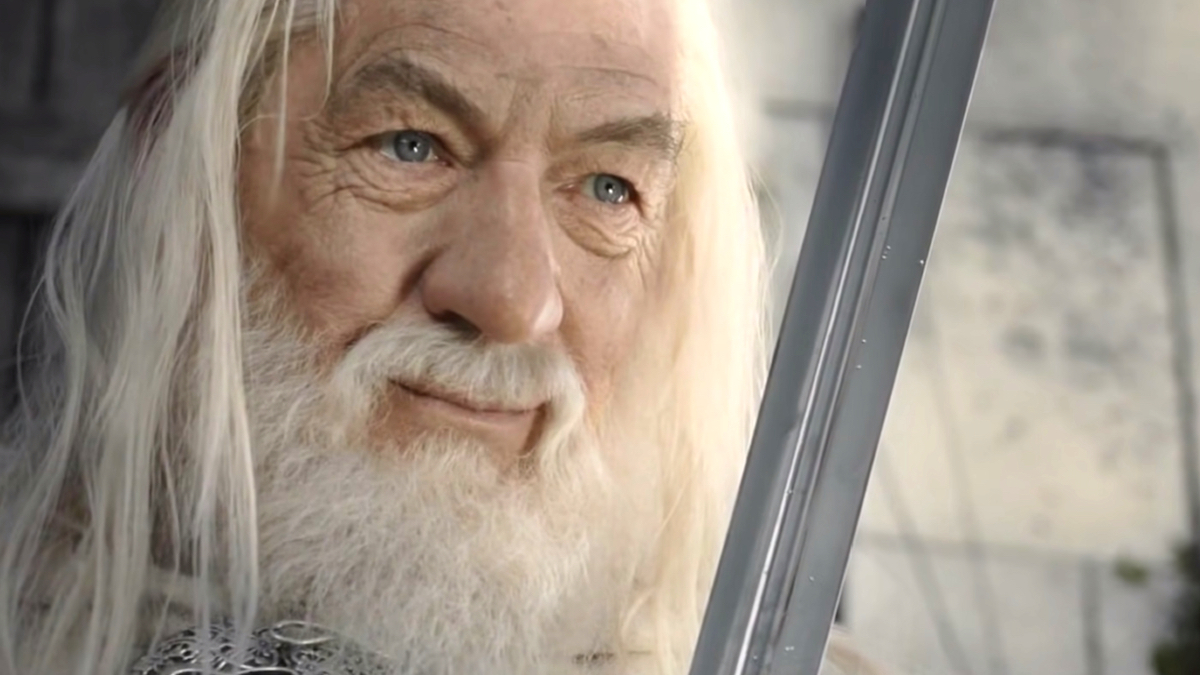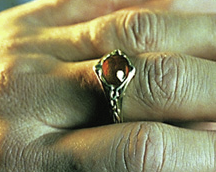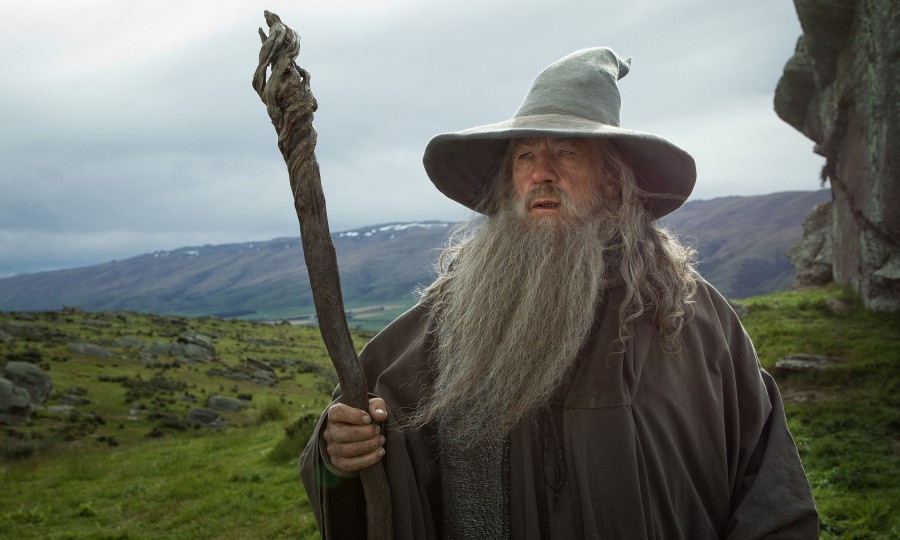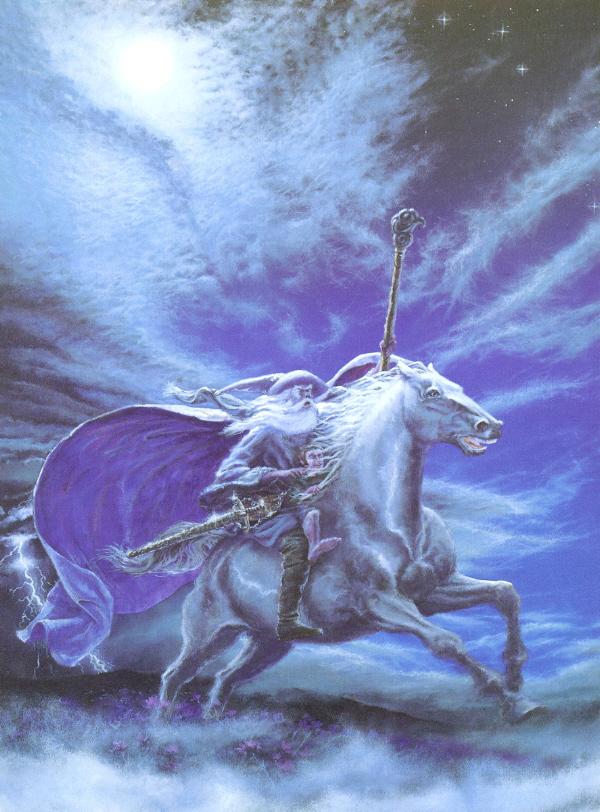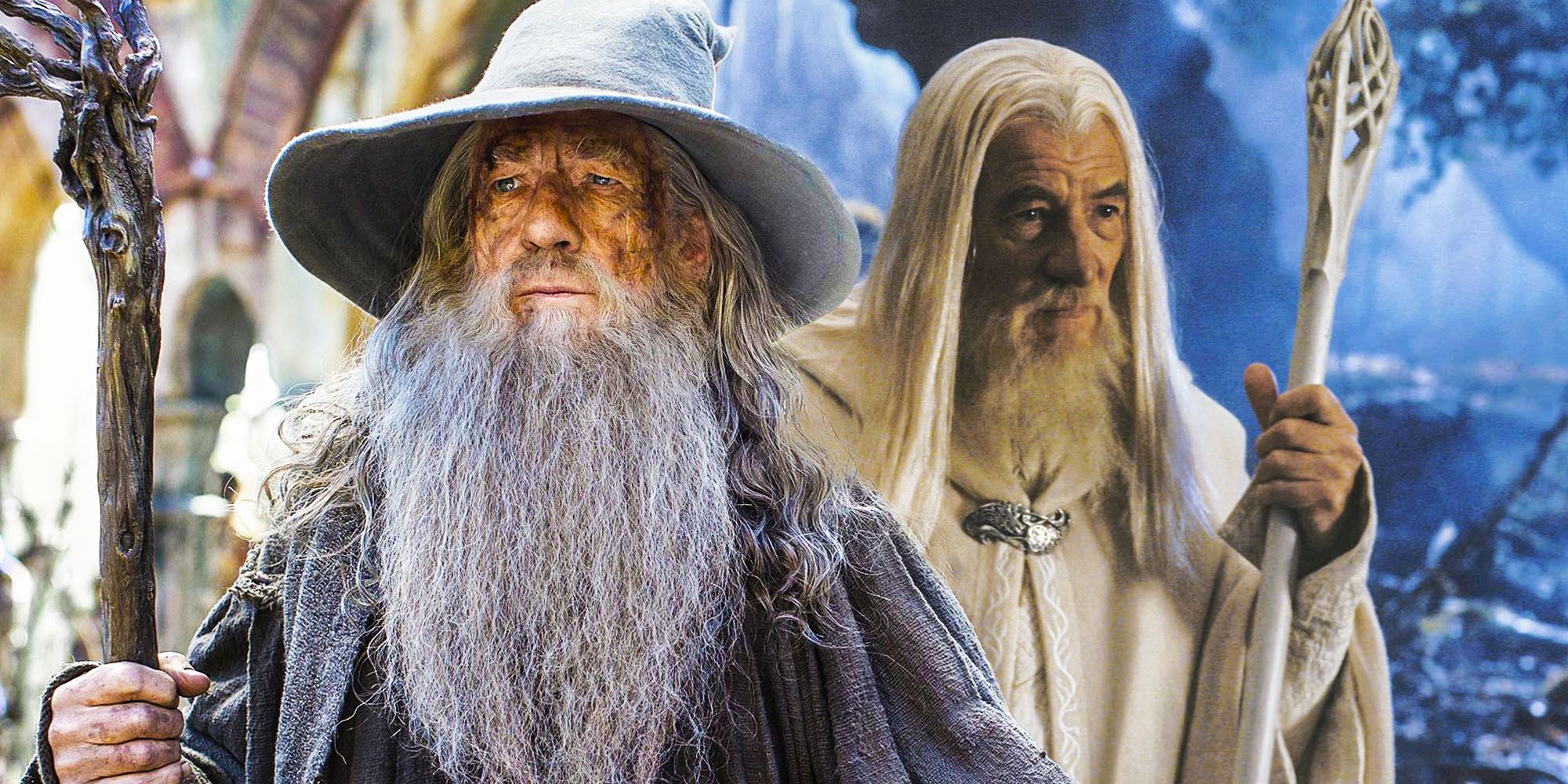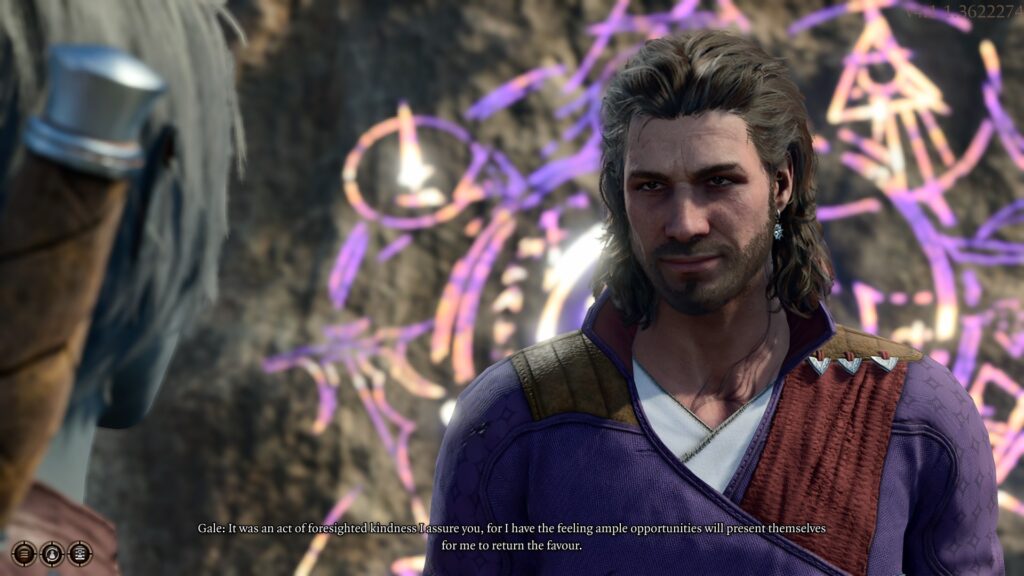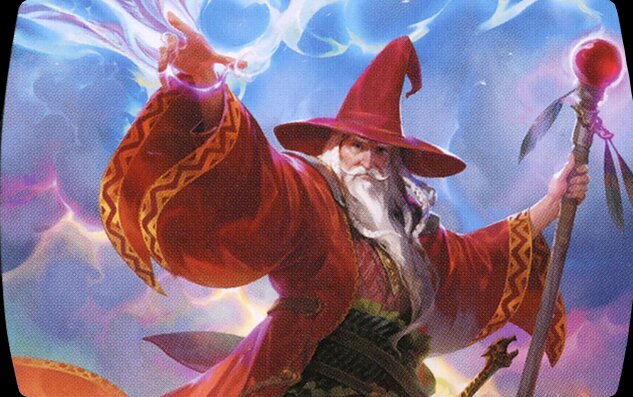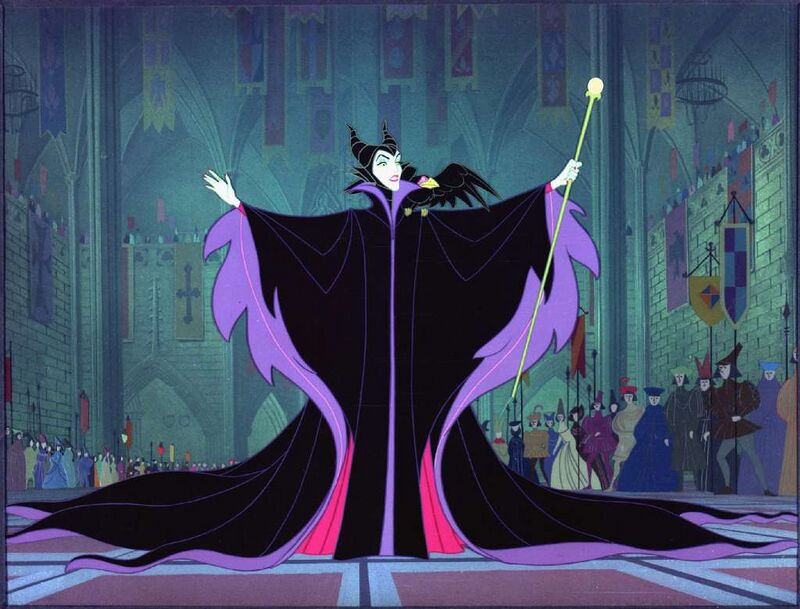Before life and before time, there was cold and silence. Then, a brilliant fire pierced through the darkness and alit creation in a great cosmic dance. This was the Secret Fire, the Flame Imperishable, the very essence of creation. At its center was Eru, who would later be called Illuvitar in the Elvish tongue.
The formless, yet living flames and light dancing around him were his children, the Ainur, who by his command performed the great Song of Creation. This song reverberated through all of existence, creating the stone foundation of the land and the life that grew on it. The beings who were sung into existence from the first verse of the Song were the purest and most incorruptible beings.
However, Melkor, who was the greatest of the Ainur, performed the Second Theme of this Music of the Ainur, which was a song of flames, storm, and ruin. Melkor fell from Eru's grace as this second verse was considered an aberration that opposed the first, which was of beauty, life and nature. A number of Ainur joined him in song, and they were shunned as well. Melkor was renamed Morgoth, and those who joined him were reshaped as terrible and great beings of flame and shadow.
The Third Theme was like a clash of two songs, the notes from the first were used again, but this time in sorrow as an answer to Melkor's wanton ruination. This third verse created discord among the Ainur and chaos came to be, the consequences of which are still felt to this day.
In anger, Eru ceased the song and began a master plan to preserve his creations from all those who would seek to ruin it. Among the Ainur were the Valar, who were like gods to the beings who came from the earth. And beneath them were the Maiar, a number of which took physical form as the Istari, who were appointed as guides and advocates of nature and the free peoples of the land, who would call them “wizards”.
These Wizards formed the White Council as agents of nature and ageless guides to the lifeforms of Arda (later Earth) for hundreds of thousands of years. The chiefest among them was Saruman the White, and second in command was the Grey Wizard, and the Maia who took physical form to fill this role in the Third Age was called Gandalf.
Gandalf, in contrast to being an angelic, godlike being is kind and humble, and is a friend of nature. He has great affinity with nature spirits and the “little folk”, namely Hobbits and Dwarves.
Gandalf was sent to Arda for the express purpose of opposing Sauron, the most powerful of the Maiar who followed Morgoth. In the Second Age, after the defeat of Morgoth, Sauron-who was one of Morgoth's few remaining underlings during this time- tricked the elves into forging the Rings of Power, which gave him control over the leaders of men.
Gandalf is mainly known for gathering and leading Thorin Oakenshield and his twelve Dwarven followers, along with the Hobbit Bilbo Baggins through the Misty Mountains and to Mount Erebor to reclaim it from the dragon Smaug. His second adventure took place sixty years later after the discovery of Sauron's Ring of Power, kicking off the events of the War of the Ring in which he gathered forces against Mordor in order to assist Frodo in taking the Ring to destroy it in Mount Doom.
Little is known about Gandalf's life outside of these two events, but he has lived for thousands of years, befriending prominent figures like Tom Bombadill, Gwaihir the Windlord, and Elrond of Rivendell.
Profile
Gandalf
"I am Gandalf, and Gandalf means me!"
Aka Gandalf Stormcrow, Olorin, The Grey Wizard
Age: approx. 3000 years
Rank and Occupation:Grey Wizard, then White Wizard
Base of operations: None (Nomadic)
Alignment: Neutral Good
Canon
Tolkien canon can be very overwhelming for newcomers due to its densely rich lore and Tolkien's insistence on giving everyone and everything at least four names. The Hobbit and the Lord of Rings books are relatively simple enough to follow, it's the Silmarillion where things get a little abstract and complicated as it's basically the entire history of Middle Earth and beyond before the events of the other stories, all the way back to the world's creation.
Don't worry though, you won't get lost so long as you can understand the main idea of Tolkien's works: “War sucks but I think trees are pretty neat.”
The Hobbit, the Lord of the Rings trilogy of novels, and the Silmarillion are the primary canon for the Tolkien-verse. The interviews, addendums, Appendices, and Christopher Tolkien's additions, corrections and other author statements are what I consider to be supplementary material to the primary canon.
Then you have adaptations, the most notable of which are the 70s animated films and the modern Peter Jackson live action films. Up until the live action Hobbit Trilogy, these are effectively the same canon as the books, with the Extended Editions of the Lord of the Rings movies being considered the definitive way of experiencing Tolkien's works. The movies make minor changes in artistic representation or dialog, but for the most part they are the same story as the books. If there is a character or event that was in the book but not the movie, the idea is “it happened offscreen”.
So these adaptations are effectively retellings of the same events. This is true to the spirit of Tolkien's writing, who would narrate the events of the stories from his perspective as if it were our own history.
I mentioned before that was the case before the Hobbit movies, and I'll explain why that's the case. The goal of the Lord of the Rings Trilogy was to faithfully adapt Tolkien's novels to the big screen, which they did, with only minor differences that can be chalked up to artistic licensing (ie, Balrogs having wings, the Eye of Sauron being a physical object so the audience can see it, etc). Initially, the Hobbit was approached with the same idea. It was planned to be split into two parts, An Unexpected Journey and There and Back Again. It would adapt all of the events from the book and tie up the “Jacksonverse” of Tolkien movies with a neat little bow, the Hobbit being the send-off to that cinematic universe. The corporate higher-ups, however, had different plans, and wanted to recreate the success of the LotR movie trilogy, and forced the movies to be stretched out into a trilogy. As the Hobbit is only one book as opposed to three, entirely original characters and side plot lines were made up to pad out the run time.
So what you are left with are beautifully faithful recreations of events from the book with huge chunks of filler in between. I regard these filler moments the same way one would anime filler, with the books being the primary “manga” canon. I will be including feats from this but will be referring to it as “movie filler”.
Then there are the video games. There's the Hobbit PS2 game, the Middle Earth series of games, and then the movie licensed adaptations. The games are retellings but the movies and books take precedence over them. Middle Earth: Shadows of Mordor and Shadows of War are original stories that take place within Tolkien's universe, as a sort of secondary canon. It won't be all that relevant to this blog, but there's some decent scaling and abilities you could pull from those games for other characters. The awful Gollum game that came out recently doesn't really have a lot of worthwhile information, and the only notable thing Gandalf does in that game is interrogate Gollum on the whereabouts of the Ring, which is already from the books anyway.
And then Rings of Power is a result of Amazon only owning Tolkien IPs in a very limited sense, and as such is an entirely separate and original story, pretty much a separate universe, so I won't be pulling from that other than maybe some images or videos just for artistic reasons.
Powers and Abilities
Metaphysical Presence
If you've read the books or watched the movies, you may notice that Frodo goes invisible when he puts on the One Ring, while beings like Sauron and whatever the heck Tom Bombadill is do not. This is because what is actually happening when Frodo, Bilbo, and others put on the Ring is they are being transported to the Unseen World.
The Unseen World is a parallel dimension where one can interact with objects in the physical world but are invisible and intangible to those that cannot. However, beings like the Nazghul can exist simultaneously in both the Unseen and physical world, allowing them to not only perceive but also interact with and harm whoever puts the Ring on. The Ring itself also puts off an energy that is perceptible to those who exist within the Unseen World, which is true for all magical objects and beings.
Sauron, being a Maia, does not go invisible when wearing the Ring because he already exists in both worlds, and can also sense others who enter the Unseen World and carry his Ring. We can also attribute this property to Gandalf, and I am not just making favorable assumptions here, as Gandalf is seen interacting with the Unseen World a few times in the movies, such as when he first touches the Ring and sees the Eye of Sauron, when he senses the Balrog in Moria, and when Saruman and Pippin use the Palantir.
So, Tl;dr Gandalf can interact with the Unseen World and thus can perceive and touch things that are within that reality, and is unaffected by magic that transports one there.
Nature Magic
When most people hear the word “nature” they'd probably think of trees and animals. While this does fall under the things that Gandalf can manipulate, nature is used in a much broader sense in Tolkien's works, and refers to any of creation that is not man-made.
This gives Gandalf a wide range of abilities, such as manipulation of both light and shadow, and can alter his voice to be deeper or louder.
https://youtube.com/playlist?list=PLCiJVrVHvzoLzV1FQlvlduj2kGmd75mC0&si=Naa4G9jwzRyT-b7S
(Ch. 1 5:00, 22:00)
He can manipulate smoke, altering its color, size, and shape.
Gandalf can manipulate sound and cast his voice to other locations, as well as mimic the voices of others. (Ch.2 24:00)
His Nature Magic also grants him Pyromancy (1:53), and can manipulate heat as well as ignite things that aren't typically flammable, such as swords.
Gandalf can also speak the language of nature, allowing him to speak to animals to send messages. He also knows Black Speech and the language of the trees.

Gandalf can also control wind, summon lightning and shatter stone.
Firework Magic
(3:50)
Gandalf possesses many magical fireworks, but can also conjure fireworks on his own, likely an extension of his Pyromancy. He can create flashes and sparks of light to distract or blind enemies, and in the Hobbit books created sparks that knocked out a room full of goblins (see link below).
He also created large fireworks that were visible from the nearest mountain peak.
m/playlist?list=PLCiJVrVHvzoLzV1FQlvlduj2kGmd75mC0&si=Naa4G9jwzRyT-b7S
(Ch.4 10:00 and 19:00)
Telekinesis
Technically an extension of Gandalf's nature magic, as it applies to all creation around him. We see in his fight against Saruman that Istar can telekinetically grab and slam objects and people around. Gandalf himself can also counter and fight back with TK of his own up until Saruman gets the upper hand.
Psychic manipulation and Possession Resistance
Moreover, Saruman is said to have power over others with his voice. The fact that he resists his suggestion to join Sauron speaks of Gandalf's ability to resist his manipulation. He is also able to remove Saruman's possession over King Theodin later.
Flame of Anor
“I am a servant of the secret fire, wielder of the Flame of Anor. Your dark fire will not avail you, Flame of Udun! Go back to the shadow!”
The Flame of Anor that Gandalf refers to here is his own godly light that is his essence as a Maia, the flames of creation. Anor is the Elvish word for sun, and as such Gandalf is able to conjure sunlight as well as project beams of angelic light-based magic that enhance his attacks or reinforce his weapons, as well as create magical barriers. Said attacks and barriers are especially potent as they were used to block and damage Durin's Bane, more on that in the Feats section.
Anti-logia hax
A VS term referring to a character's ability to interact with things of liquid viscosity. As Gandalf was falling with Durin's Bane, they grappled each other and they fell through water, where he transformed into "a thing of slime, stronger than a strangling snake" and Gandalf kept his grasp.
Resurrection
After fighting the Balrog for several days, Gandalf dies of exhaustion. About two days later, he was reborn as Gandalf the White. The precedence of this resurrection, however, is a bit of a special circumstance. Gandalf explains after dying he was “sent back” (presumably by Eru) to complete his mission. This implies that this is not something Gandalf can do on his own.
However, there are cases where other Maiar become physical again after death without help, such as Sauron, but that may be because he is the most powerful of the Maiar.
I would give Gandalf the benefit of the doubt here though, as Sauron's resurrection into physical form was a process that took time, and Eru simply skipped all that for Gandalf and sent him back immediately.
Weapons and Equipment
Narya
Narya is one of the Elvish Rings of Power, gifted to him by the elf Cirdan after he predicted Gandalf would put it to good use.
Narya contains the power over fire, which not only includes manipulation of physical heat and flames, but also metaphysical fire such as the flame that resides in the hearts of the people. This allows his some degree of persuasion and charisma over others, regarded as an inspiring leader and guide for others on their quests.
It also bolters his own internal “flame”, giving him an indomitable spirit and a significant stamina boost. He can fight for hours or even days nonstop with little to no sustenance, which can be attributed to the power of his Ring.
After Sauron's defeat and the destruction of the One Ring, Sauron's corruption no longer affected the other Rings of Power, allowing them to use them without risk of being influenced by him. Although, it didn't seem to affect those who possessed the Elven Rings of Power much anyway.
I would tell you about these other Elven Rings, such as the one used by Galadriel, but that's Nenya business.
I'm so sorry….
Much like the bearers of the Ring, I just couldn't resist the temptation.
Istari Staff
Staves that are used by wizards of Arda to concentrate their magical energy more efficiently. His first staff was destroyed during his fight with Durin's Bane, but his second staff is more durable and can handle more of his power.
Glamdring
An elvish blade with historical significance whose name translates to “Foehammer”. It once belonged to the elven king Gondolin in the First Age, and later discovered by Gandalf in a troll’s treasure horde.
Despite being several millennia old, it is relatively untouched by time, and is just as effective in combat. It is highly durable and able to wound powerful foes such as Balrogs, and is also a useful conduit for Gandalf's magic.
Shadowfax
It feels a bit strange listing a horse as equipment, but mounts can technically be used as weapons.
Shadowfax appears as a horse, but is actually a nature spirit known as a Mearas, and is know for his exceptional speed. In Fellowship, Gandalf travels on Shadowfax from the capital of Rohan, Edoras, to the Shire in under 2 days.
Using this map, that's about a distance of 650 miles. Plugging that in to V=d/t, that's about 13 meters per second, just over the benchmark for superhuman speed.
Gandalf can summon Shadowfax by whistling.
Great Eagles
(1:46)
The Great Eagles were indebted to Gandalf after he healed their leader Gwaihir, who was wounded by an arrow.
To return the favor, they agreed to transport Gandalf where they can, within reason, as they are reluctant to travel outside their territory.
They can make some exceptions though, such as after the destruction of the One Ring, when they agreed to rescue Frodo and Samwise only after the primary threat of Mordor was eliminated.
The Eagles’ travel by flight is significantly faster than the Mearas, judging by their flight from the Misty Mountains to Minas Tirath, and can cover similar distances in about a third of the time (which would logically make them about three times as fast). They are also capable in combat, able to tear up Fell-beasts and their Nazghul riders.
The trade-off is that they are less of a summon and moreso take Gandalf's requests for assistance, which they often deny unless Gandalf is in grave danger.
Feats and Scaling
Gandalf the Grey/White
While here, there is a distinction I want to clear up. Gandalf the White and Gandalf the Grey are not technically different forms or “power-ups” in a sense. For context, Gandalf died, reverted to his Maia self, and then was reborn in a new body as Gandalf the White. He claims that he is “Saruman as he should have been”, meaning he is a White Wizard now on par with Saruman, which basically just means he can use more of his Maia power in his physical form. As such, feats from both the White and the Grey can both be considered what Gandalf is capable of in his physical Istar body.
https://youtu.be/OKzPGjl5ees?si=q4KUOj1hh8Xw-QWu
Scales to Radaghast, who blocked and deflected hits from the Witch King in movie filler
Fights four of the Nazghul at once, and his clash with them caused considerable amounts of light and flame.
"But they closed round at night, and I was besieged on the hill-top, in the old ring of Amon Suˆl. I was hard put to it indeed: such light and flame cannot have been seen on Weathertop since the war-beacons of old. At sunrise I escaped and fled towards the north."
https://youtu.be/3bReJswiMGM?si=NPzGLFXMo8BKY-BC
Destroys the Bridge of Kazad-dum
https://youtu.be/3fbhVPnhX-4?si=Ev_SbbJbMRYWoSZ_
Parts the clouds during the Battle of Helm's Deep
https://youtu.be/KGC3f7L_ek8?si=bcP5ylIc-_IGp7dU
Blocks out the sun at Rivendell
https://youtu.be/Axyl7rXNK9o?si=MReuaF80KIarakTL
Creates a large energy blast that briefly knocks out everyone in a room with at least a hundred goblins. He then proceeds to fight a horde of goblins, slay the Great Goblin, and take a tumble down several thousand feet and come out completely unscathed.
https://youtu.be/OdjGPV8X-l4?si=iXQdbR9DI9FwXNqN
Scales to the Witch King who creates a large beacon of light that reaches the clouds (0:32)
And of course, his most iconic feat, his battle with Durin's Bane, better known as the Balrog.
Even disregarding power scaling, this is still an impressive strength feat and showing of martial skill, as he blocks hits from and grapples with an enemy several times larger than him.
Now, there's an important distinction between when Gandalf defeats the Balrog between the movie and the book. In the movie, the Balrog simply just falls flat and Gandalf narrates “I smote his ruin onto the mountainside”. In the book, it's a bit more literal, as in the act of slaying the Balrog destroyed the mountainside.
"I threw down my enemy, and he fell from the high place and broke the mountainside where he smote it in his ruin."
It's unclear just how much of the mountainside was destroyed, but Oxford Dictionary defines a Mountainside as the “sloping surface of a mountain”. So with that we can have a general idea for a baseline.
This map is taken from the Encyclopedia of Arda
Going by the scale at the top, the side of Mt Cerebdil, from the perspective of Durin's Tower where Gandalf and the Balrog were fighting, is roughly five miles from peak to valley.
From the book's description, it “broke”, so we'll use the value for pulverization.
214J/cc
I'll use volume of a pyramid since it's a slope going downward and a peice of a mountain. For length and height I'll say 5 miles, and width about 2.5 miles.
5x5x2.5=62.5
62.5/3=20.8
20.8mi=approx. 33.5km
Or 3350000cm
3350000×214
7169000000J
Or 17 tons tnt equivalent
City block level
But wait, it gets better. In the 1978 animated movie, the mountain is destroyed in its entirety during their fight.
Using the map from before again, the mountain is about 30 miles in length, 10 miles in width, and again 5 miles in height.
V=(30×10×5)/3
V=500mi^3
8.047e+7 or about 80 million cm
80470000x214
17220580000 Joules
Or 411 tons TNT equivalent, Large Multi-City Block level
For comparison's sake, that's about 40 times the payload of a MOAB.
And this actually corroborates with a feat from the Fellowship movie, where Saruman attempts to destroy the mountain that Gandalf and the others are standing on, but Gandalf counters it and drastically minimizes the damage to a small surface area.
(2:12)
So, we can comfortably conclude this as a high end for Gandalf's Destructive Capacity in his Istar form.
Maia Form
When killed, Gandalf will revert to a Maia and become a cosmic being of flame and light. However, he can no longer interact with the physical world in this state unless he creates another physical form to do so.
So the inclusion of Gandalf's Maia form in a VS battle would be somewhat situational.
For example. Say Gandalf's opponent killed Gandalf in his physical Istar body but realized he resurrected later. This opponent would have to be aware of Gandalf's Maia form and have the ability to interact with him in that state in order to prevent him from resurrecting again. This assessment of his power in this form is here for those cases.
The bigger feats in Tolkien-verse cosmology are usually attributed to the Valar, who are a level above the Maiar, but there is a feat that includes all the Ainur, that being the Song of Creation.
Ah, see how it came full circle? Almost like… a ring.
Luckily, we can actually know how many Ainur there were, and we can divide this creation feat among the number of them. Of course, this wouldn't divide evenly among each of them as power varies between them, but we can use this as a benchmark for an absolute high end for Gandalf's power.
So, there were fifteen Valar. About 3-7 Maiar became Balrogs, one became Sauron, and another five to seven became Istar. I'm going to assume the maximum number for each.
So 15+7+1+7=30
GBE of Earth is about 60 zettatons.
60/30=2
So, assuming maximum high end, Gandalf as a Maia should be capable of putting out 2 Zettatons worth of energy, which is somewhere in the benchmark Small Planet or Planetoid Level.
Now, keep in mind, this is an absolute high end. Gandalf's true power as a Maia is unfortunately difficult to pinpoint, and would be somewhere between the high end for the mountain destruction feat and this number (which is admittedly a frustratingly large margin) .
Secondly, he is unable to use this full power in the physical world as he is incorporeal. His opponent would need to able to Astral project, have significant spatial hax or other abilities that can affect him on this level, or be able to travel to other planes for this to be viable.
Wisdom and Intelligence
Gandalf has lived for thousands of years, and his council is often sought by beings of similar nigh-immortality such as Elrond and Galadriel. Istar of higher ranks are also considered to be wiser than their lower-ranking counterparts such as Radaghast, who often communes with nature spirits.
When sent back as Gandalf the White, he got an intelligence boost, claimed to be “stronger and wiser” on the same level as Saruman, and after the events of the War of the Ring was the White Wizard, the highest ranking Istar.
He is also capable of clever warfare tactics that outsmarted Sauron, such as when he used Sauron's knowledge that a Hobbit named Baggins had the Ring as a distraction, using Pippin's vision with the Palantir to divert his attention away from Mount Doom to allow Frodo and Sam to pass with much less resistance.
During Fellowship, he also shows Investigation skills, gathering information on Sauron's Ring to confirm that the Ring Bilbo had was the same one.
Weaknesses
While powerful in Istar form, he is still flesh and blood and can be harmed by beings of similar or higher power, which is obviously true for most VS combatants. Technically speaking, his only real weaknesses are the limitations of his abilities; for example his high stamina which allowed to battle Durin's Bane for 4-8 days depending on the source, but eventually still died of exhaustion in spite of his exceptional staying power.
While usually incredibly patient, planning and preparing for the right moment to act for centuries and able to fight for hours to days to deliver a decisive blow, he has rare moments where he loses his temper, such as in the above clip. For context, however, this is the third time Pippin did something to jeopardize the rest of the group. He only seems to be actively angry when someone's actions endanger someone else.
Summary
+MCB DC and dura
+can sense magic and the metaphysical
+Can spam projectiles at long range
+Energy shields
+Can blind or distract opponents with smoke and Fireworks Magic
+Has impressive martial skills
+nigh-immortality with 3000+ years life and limited resurrection
+can resist spatial hax and bfr with metaphysical presence
+anti-logia hax
+has summons
+exceptional survivability and stamina, can fight for up to eight days
-low speed for his leveling tier
-the criteria for accessing his Maia form for combat are very situational
-his summons are limited and can deny his call
Me after doing all this research:
Suggested Opponents
Gandalf the Grey and Gandalf the White and Monty Python and the Holy Grail's Black Knight and Bonito Muscollini and the Blue Meanie and Cowboy Curtis and Jambi the Genie, Robocop, Terminator, Captain Kirk, Darth Vader, Lo Pan, Superman and every single Power Ranger, Bill S Preston, Theodore Logan, Spock, the Rock, Doc Ock and Hulk Hogan
Gale of Waterdeep
(Wizards of the Coast Multiverse)
(Spoilers for Baldur's Gate ahead)
Gale is a wizard from Baldur's Gate 3, which takes place in the universe of Dungeons and Dragons, which falls under the larger umbrella of the Wizards of the Coast shared multiverse (Magic the Gathering, etc.). Gale was once a magical prodigy, able to not only cast spells but manipulate the magic that fueled them. He was taken in as a pupil of the legendary wizard Elminster before being noticed by the Goddess of Magic herself, Mystra.
Overeager to impress her, Gale attempted to return her a piece of her essence that was lost in the Shadowfell, instead cursing himself with a Netherese Orb now embedded in his chest forcing him to absorb magic from enchanted artifacts periodically lest he release a cataclysmic explosion. As if not unlucky enough, Gale was one of the unfortunate victims captured by the Mind Flayer ship that invaded Baldur's Gate, now carrying a Mind Flayer parasite in his head. This parasite, however, is unique, suspended in a magical field giving him a number of Psionic abilities rather than using him as a host for the baby Mind Flayer to mature.
Gale is honestly probably the best matchup for Gandalf, as mid-tier DnD characters actually have comparable stats and abilities. Any speed gap probably wouldn't be too big, since DnD characters in general need to exploit a very specific set of speed boosts just to breach the sound barrier.
There are two things that Gandalf will have to watch out for: Gale's hax and his Netherese Orb. DnD magic at higher levels gets pretty haxy, for example time manipulation, dimensional and spatial manipulation, and transmutation. Gale can also use his Mind Flayer parasite to gain access to mind control and telepathic manipulation, as well as causing psychic damage. In one of the endings for BG3, Gale weaponizes his Netherese Orb to self destruct and take out the final boss.
How Gandalf handles these hax and the self-destruct explosion are worth looking into. Gale claims the Netherese Orb would “level Waterdeep”. If the explosion kills Gandalf, it actually makes the matchup more interesting because after dying, Gale will fulfill his penance with Mystra, becoming a godlike being in the Astral Plane, meaning he can actually interact with Maia Gandalf. How powerful Gale is in Astral form is also worth looking into, I have yet to beat Baldur's Gate and I'd like to finish my playthrough at least once before watching all the rest of the content.
Elminster
This is effectively trading a potentially even match for a thematic one. Gandalf and Elminster are considered the progenitors of the “Western fantasy wizard” archetype, though technically Gandalf predates him by almost half a century.
Elminster has access to 9th Level spells, which are notorious for being absolutely busted. For example Power Word Kill, which kills an opponent by speaking a word, True Polymorph, allowing the user to transform anyone into anything permanently, or Wish, which is pretty much what it sounds like.
However, it is possible to survive or resist these high level spells, i.e. one can survive a Power Word Kill if they have HP higher than 100, though translating game mechanics into universal VS battle concepts is always sketchy.
Elminster could also cast Dispell Magic at 9th Level, effectively turning off magic for Gandalf. It is questionable, however, if it would work the same as for DnD magic, as Tolkien “magic” is less traditional fantasy magic and moreso godly powers that mortals perceive as magic.
And that's essentially Gandalf vs Elminster; an argument whether Gandalf is able to resist Elminster's hax to make it less one-sided in the latter's favor. I'd much rather have Gandalf fight Gale instead of his teacher.
Obi-Wan Kenobi
Obi-Wan is effectively the wise sage archetype to the heroic archetypes of Luke Skywalker and the Baggins(es), even both sacrificing themselves to save them and becoming more powerful after death.
If we restrict Obi-Wan to just Disney canon, this is an even fight for their physical forms, but I don't typically like limiting characters that way. With Expanded Universe, Obi-Wan obviously takes it, but I'm honestly more interested in Force Ghost Obi-Wan VS Maia Gandalf, due to it being likely that Obi-Wan can actually interact with him considering he exists within the Living Force as an incorporeal being. Both of them in this state are capable of manipulating reality of up to a planetary scale using high ends.
Maleficent
Maleficent has dc and dura in the ballpark of Gandalf, though some high ends put her at Town Level. Speed is honestly hard to pin down given the medium, though I would be generous and say somewhere in the ballpark of Superhuman. She has plant manipulation, fire manipulation, transmutation, and telekinesis that can keep up with Gandalf's. Glamdring and Gandalf's combat experience and physical strength would be enough to contend with her dragon form.
The only issue is that she is Town Level high end, and Gandalf's Maia form would not come into play.
Master Roshi
This would actually be a really cool fight, unironically. I know I said earlier I don't like to limit characters, but that's pretty much the only way this fight can happen.
If we restrict Roshi to only his original Dragonball Manga canon feats and disregard outliers such as his moonbust, and the power scaling nightmare that is Dragonball Super (like trading blows with Jiren, are you crazy?? Does anybody know how strong these characters are supposed to be??)
Roshi in the manga has a similar mountain-busting feat to Gandalf, and has a variety of magic-like abilities to contend with his nature magic such as size manipulation, electrokinesis, mind control, and the sealing Mafuba. I could easily see a Kamehameha clashing with the Flame of Anor as Gandalf says the line, you know the one.
The only issue is that, scaling to Kid Goku dodging natural cloud to ground lightning, Roshi is massivley hypersonic and blitzes all over Gandalf's just over baseline superhuman speed, even when taking Gwaihir into account. However, Gandalf may be durable enough for speed to not be a game-changer, and Gandalf has no issue dragging fights out into a war of attrition, and may be able to drain Roshi's ki over time.
However, for this scenario to be feasible, it just doesn't seem fair to cherry pick out Gandalf's best feats and high ends while disregarding Roshi's moon leveling high ends as outliers and isn't really my style of debating or vs battling.
Universal/Multiversal Roshi from the Dragonball Super Manga is absolutely an outlier though because HAHA WHAT.
----------------------------------------------------------------------------------------------------------------------
Obligatory outro commenting on how low it's been since I've done one of these.
A Hero's Shade is never later, nor is he early. He arrives precisely when he means to!
Idk read my blogs please, I crave validation.
